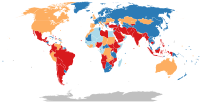
Photo from wikipedia
This paper considers a population being affected by a mortality stress during a limited period of time, for example a pandemic. It has recently been suggested that the mortality stress… Click to show full abstract
This paper considers a population being affected by a mortality stress during a limited period of time, for example a pandemic. It has recently been suggested that the mortality stress during a pandemic can be viewed as a temporary shift in apparent age. We instead suggest to use a frailty based model where the baseline mortality rate is being stressed. This approach will in a natural way imply post-pandemic mortality rates at the population level. In particular, analytical results concerning the population mortality rate during and after a pandemic are derived. Under general assumptions it is shown that, compared to a non stressed scenario, the mortality is higher during the pandemic and lower after. These general results are exemplified for the Gompertz-Makeham law where more precise results can be obtained using its proportional frailty representation. The results are illustrated based on COVID-19 data for the Swedish population and we estimate the effect of the pandemic on the expected life time of an individual. [ABSTRACT FROM AUTHOR] Copyright of Scandinavian Actuarial Journal is the property of Routledge and its content may not be copied or emailed to multiple sites or posted to a listserv without the copyright holder's express written permission. However, users may print, download, or email articles for individual use. This abstract may be abridged. No warranty is given about the accuracy of the copy. Users should refer to the original published version of the material for the full abstract. (Copyright applies to all Abstracts.)
Journal Title: Scandinavian Actuarial Journal
Year Published: 2021
Link to full text (if available)
Share on Social Media: Sign Up to like & get
recommendations!